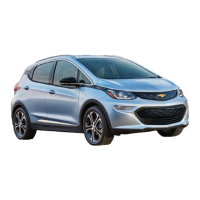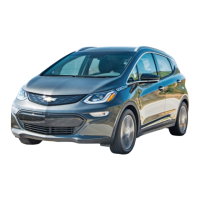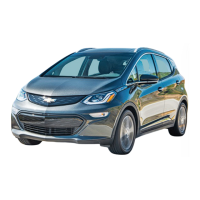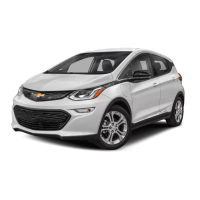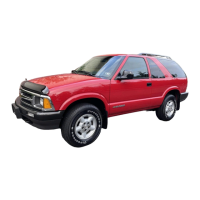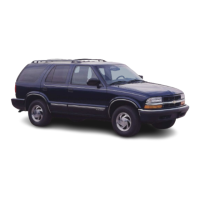Do you have a question about the Chevrolet BOLT EV2017 and is the answer not in the manual?
Explains hazard levels and what to do to avoid or reduce them.
Explains how to adjust head restraints for proper safety.
Explains the passenger sensing system and its function with airbags.
Explains how FPB helps avoid or reduce harm from front-end crashes with pedestrians.
Explains how RCTA warns of traffic crossing the vehicle's path when reversing.
Warns about exposure to high voltage components and handling.
Details the process of AC charging using the charge cord.
Explains the process of DC charging using a DC fast charge station.
Outlines requirements for grounding the charge circuit.
Warns against DIY service on high voltage components.
Discusses keeping the vehicle plugged in for battery temperature.
Advises on tire inflation, alignment, and cargo weight.
Covers keys, locks, and remote entry systems.
Details liftgate operation and vehicle security features.
Covers basic key information and warnings.
Explains the rear door safety lock feature.
Covers the vehicle's security system, alarm, and immobilizer.
Describes the anti-theft alarm system.
Details the steps for arming the vehicle alarm system.
Details the passive theft-deterrent system.
Explains the operation of the immobilizer system.
Covers head restraint adjustment and importance.
Details seat adjustment, reclining, and heating features.
Explains proper use, pretensioners, and care of safety belts.
Details the airbag system, its components, and operation.
Covers older children, infants, and proper restraint use.
Advises on safety belt use for older children who have outgrown booster seats.
Emphasizes the need for restraints for infants and young children.
Describes the three basic types of child restraints: rear-facing, forward-facing, and booster seats.
Details how to secure child restraints using seat belts or LATCH.
Emphasizes proper securing of the child in the restraint.
Advises placing child restraints in rear seating positions for safety.
Explains the LATCH system for securing child restraints.
Details how to secure child restraints using seat belts in the rear seat.
Explains how to secure child restraints using seat belts in the front seat.
Explains various warning lights, gauges, and indicators.
Explains the operation of the windshield wiper and washer lever.
Explains how to use climate control buttons and touch screen.
Indicates the high voltage battery is depleted and requires charging.
Covers distracted driving, defensive driving, and drunk driving.
Details new vehicle break-in, power button, and starting/stopping procedures.
Explains driver-selectable operating modes like Sport Mode.
Describes the electric drive unit and shift lever operation.
Covers ABS, electric parking brake, brake assist, and regenerative braking.
Details traction control and electronic stability control systems.
Covers systems that help avoid crashes or reduce damage.
Details systems like FCA, FAB, LKA, LCA for crash avoidance.
Warns of traffic crossing the path when reversing.
Explains how FCA helps avoid or reduce harm from front-end crashes.
Details how FAB provides braking assistance or automatically brakes the vehicle.
Explains SBZA as a lane-changing aid for blind zones.
Describes LCA as a lane-changing aid for avoiding crashes.
Alerts to unintentional lane departures.
Details how LKA assists with lane departures by gently steering.
Explains when and how to charge the vehicle.
Explains when the vehicle needs charging based on battery level.
Details the process for charging the high voltage battery.
Provides important safety and operational information for portable charging.
Lists electrical requirements for battery charging equipment.
Details owner checks and doing own service work.
Details how to replace various vehicle bulbs.
Covers high voltage devices, wiring, and electrical system overload.
Warns about high voltage components and wiring.
Explains how circuit breakers protect against overload.
Details the location and access to the underhood fuse block.
Explains the location and access to the instrument panel fuse block.
Lists the fuses and their usage.
Explains the importance of correct tire pressure.
Recommends inspecting tires for wear or damage.
Advises on tire rotation frequency for uniform wear.
Explains factors affecting tire wear and when to replace tires.
Warns about the effects of using non-standard tire/wheel sizes.
Explains the importance of wheel alignment and balance.
Advises on replacing bent, cracked, or rusted wheels.
Warns against using tire chains due to clearance issues.
Gives advice for handling a flat tire situation.
Provides warnings and instructions for the tire sealant and compressor kit.
Details the steps for using the kit to seal and inflate a tire.
Explains how to use the kit to inflate a tire without sealant.
Provides instructions for jump starting a vehicle.
Provides instructions for jump starting a vehicle in North America.
Identifies the positive terminal for jump starting.
Identifies the negative grounding point for jump starting.
Provides information on towing the vehicle.
Warns about incorrect towing damaging the vehicle.
Explains cleaning the windshield and wiper blades.
Advises on cleaning tires and the importance of proper care.
Advises visual inspection of brake lines, hoses, pads, and rotors.
Provides guidelines for cleaning the vehicle's interior surfaces.
Provides guidelines for proper floor mat usage and warnings.
Outlines the required maintenance schedule for the vehicle.
Lists checks and services to perform monthly.
Lists recommended fluids, lubricants, and parts.
Details the new vehicle limited warranty terms and conditions.
Outlines steps for resolving customer concerns.
Lists contact information for customer assistance.
Explains how to report safety defects to government and GM.
Explains how to report safety defects to the US government (NHTSA).
Details how to report safety defects to Transport Canada.
Provides contact information for reporting safety defects to GM.
Provides an overview of the OnStar system and its features.
Lists available OnStar services like Emergency, Security, and Navigation.
Explains hazard levels and what to do to avoid or reduce them.
Explains how to adjust head restraints for proper safety.
Explains the passenger sensing system and its function with airbags.
Explains how FPB helps avoid or reduce harm from front-end crashes with pedestrians.
Explains how RCTA warns of traffic crossing the vehicle's path when reversing.
Warns about exposure to high voltage components and handling.
Details the process of AC charging using the charge cord.
Explains the process of DC charging using a DC fast charge station.
Outlines requirements for grounding the charge circuit.
Warns against DIY service on high voltage components.
Discusses keeping the vehicle plugged in for battery temperature.
Advises on tire inflation, alignment, and cargo weight.
Covers keys, locks, and remote entry systems.
Details liftgate operation and vehicle security features.
Covers basic key information and warnings.
Explains the rear door safety lock feature.
Covers the vehicle's security system, alarm, and immobilizer.
Describes the anti-theft alarm system.
Details the steps for arming the vehicle alarm system.
Details the passive theft-deterrent system.
Explains the operation of the immobilizer system.
Covers head restraint adjustment and importance.
Details seat adjustment, reclining, and heating features.
Explains proper use, pretensioners, and care of safety belts.
Details the airbag system, its components, and operation.
Covers older children, infants, and proper restraint use.
Advises on safety belt use for older children who have outgrown booster seats.
Emphasizes the need for restraints for infants and young children.
Describes the three basic types of child restraints: rear-facing, forward-facing, and booster seats.
Details how to secure child restraints using seat belts or LATCH.
Emphasizes proper securing of the child in the restraint.
Advises placing child restraints in rear seating positions for safety.
Explains the LATCH system for securing child restraints.
Details how to secure child restraints using seat belts in the rear seat.
Explains how to secure child restraints using seat belts in the front seat.
Explains various warning lights, gauges, and indicators.
Explains the operation of the windshield wiper and washer lever.
Explains how to use climate control buttons and touch screen.
Indicates the high voltage battery is depleted and requires charging.
Covers distracted driving, defensive driving, and drunk driving.
Details new vehicle break-in, power button, and starting/stopping procedures.
Explains driver-selectable operating modes like Sport Mode.
Describes the electric drive unit and shift lever operation.
Covers ABS, electric parking brake, brake assist, and regenerative braking.
Details traction control and electronic stability control systems.
Covers systems that help avoid crashes or reduce damage.
Details systems like FCA, FAB, LKA, LCA for crash avoidance.
Warns of traffic crossing the path when reversing.
Explains how FCA helps avoid or reduce harm from front-end crashes.
Details how FAB provides braking assistance or automatically brakes the vehicle.
Explains SBZA as a lane-changing aid for blind zones.
Describes LCA as a lane-changing aid for avoiding crashes.
Alerts to unintentional lane departures.
Details how LKA assists with lane departures by gently steering.
Explains when and how to charge the vehicle.
Explains when the vehicle needs charging based on battery level.
Details the process for charging the high voltage battery.
Provides important safety and operational information for portable charging.
Lists electrical requirements for battery charging equipment.
Details owner checks and doing own service work.
Details how to replace various vehicle bulbs.
Covers high voltage devices, wiring, and electrical system overload.
Warns about high voltage components and wiring.
Explains how circuit breakers protect against overload.
Details the location and access to the underhood fuse block.
Explains the location and access to the instrument panel fuse block.
Lists the fuses and their usage.
Explains the importance of correct tire pressure.
Recommends inspecting tires for wear or damage.
Advises on tire rotation frequency for uniform wear.
Explains factors affecting tire wear and when to replace tires.
Warns about the effects of using non-standard tire/wheel sizes.
Explains the importance of wheel alignment and balance.
Advises on replacing bent, cracked, or rusted wheels.
Warns against using tire chains due to clearance issues.
Gives advice for handling a flat tire situation.
Provides warnings and instructions for the tire sealant and compressor kit.
Details the steps for using the kit to seal and inflate a tire.
Explains how to use the kit to inflate a tire without sealant.
Provides instructions for jump starting a vehicle.
Provides instructions for jump starting a vehicle in North America.
Identifies the positive terminal for jump starting.
Identifies the negative grounding point for jump starting.
Provides information on towing the vehicle.
Warns about incorrect towing damaging the vehicle.
Explains cleaning the windshield and wiper blades.
Advises on cleaning tires and the importance of proper care.
Advises visual inspection of brake lines, hoses, pads, and rotors.
Provides guidelines for cleaning the vehicle's interior surfaces.
Provides guidelines for proper floor mat usage and warnings.
Outlines the required maintenance schedule for the vehicle.
Lists checks and services to perform monthly.
Lists recommended fluids, lubricants, and parts.
Details the new vehicle limited warranty terms and conditions.
Outlines steps for resolving customer concerns.
Lists contact information for customer assistance.
Explains how to report safety defects to government and GM.
Explains how to report safety defects to the US government (NHTSA).
Details how to report safety defects to Transport Canada.
Provides contact information for reporting safety defects to GM.
Provides an overview of the OnStar system and its features.
Lists available OnStar services like Emergency, Security, and Navigation.
| Brand | Chevrolet |
|---|---|
| Model | BOLT EV2017 |
| Category | Automobile |
| Language | English |
